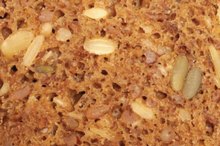Which Types of Pasta Raise Blood Sugar?
Carbohydrates contain sugars, starches and cellulose. During the digestive process, the rate at which carbs are broken down and absorbed into the bloodstream depends on their molecular structure – whether they are simple or complex carbs. The foods eaten with carbohydrates also play a role in the rate of absorption into the bloodstream. Because they are carbohydrates, certain types of pasta can elevate blood sugar. If you are watching your weight or have a health problem, such as diabetes, it is important for you to know your pastas.
Carbs and Blood Sugar Levels
Your body keeps a check on blood sugar levels by releasing the hormone insulin into the bloodstream whenever blood sugar levels become elevated. Pasta made from semolina, farina and refined durum wheat flour are digested more quickly than pasta made from whole-grain durum wheat. The speed at which pasta and other simple carbs made from refined flour products are digested influences your blood sugar levels and contributes to those sugar highs and lows that deplete energy and trigger hunger. Eating these products over an extended period can contribute to obesity and damage health.
Cooking Methods
Can You Have a Salad for a Post-Workout Meal for Women?
Learn More
The way you cook pasta can contribute to elevated blood sugar. The longer you cook it, the softer pasta becomes. The carbohydrates in pasta softened by cooking break down rapidly during the digestive process, causing an increase in blood sugar levels. Shorten cooking time and eat your pasta al dente – slightly firm. According to Joan Marie Warner, MS, RD, CDE, Utah Department of Health, pasta cooked for 40 minutes is considered to have a high Glycemic Index rating; pasta cooked for 15 minutes has a medium GI rating, and pasta cooked for about 6 minutes has the lowest GI rating. The Glycemic Index rates carbohydrates according to the rate at which they raise blood sugar levels.
Combining Foods
You can delay the increase in blood sugar levels by combining pasta made from refined flour with other foods, such as vegetables, grated cheese or olive oil. A study published in the European Journal of Clinical Nutrition in February 2003 compared the effects of pasta meals with and without added fiber and fat on blood glucose – blood sugar levels. Pasta meals containing 30 grams of polyunsaturated fat and 3 grams of sodium propionate fed to one group of study participants delayed the rate of digestion and decreased bloodstream levels of glucose and insulin compared with study participants eating pasta without fat.
Health Benefits in White Pasta
List of Slow & Fast Carbs
Learn More
Whole-grain pastas contain more vitamins, minerals and protein than white pastas, according to Kansas State University. However, enriched white pasta contains some nutritional benefits, such as iron and B vitamins. Because pasta is a plant protein, it does not contain one or more amino acids necessary for it to be considered a complete protein. Animal sources of protein are complete proteins. Make your pasta meal a complete protein by topping it with grated cheese or eating it with low-fat meat, chicken or fish.
Related Articles
References
Resources
Writer Bio
Sara Tomm began writing in 1971. She holds certificates in the medical, physiological and nutritional principles and treatment modalities for eating disorders. As a weight-management consultant, Tomm authored educational materials relating to the medical, psychological, environmental and social aspects of eating disorders, nutrition and physical fitness. She studied at Columbia University, Henry George School of Social Science, Farmingdale State College and Suffolk Community College.








